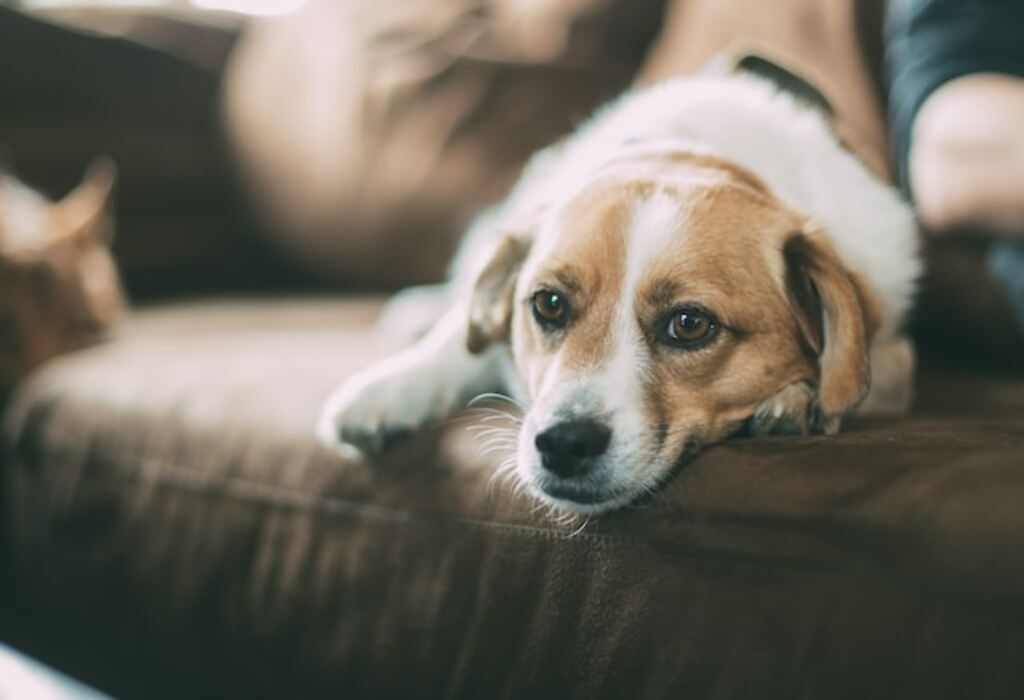Have you ever wondered why your furry friend prefers to sit on you rather than anywhere else? Dog sitting behavior can vary from sitting in your lap to sitting on your feet, chest, or even head. In this article, we will explore the different types of dog sitting behavior and delve into the reasons why dogs may opt to sit on humans.
So, what does it mean when a dog sits on you? Is it a sign of affection or something else? Understanding the meaning behind a dog’s sitting behavior can help you strengthen your bond with your furry friend and ensure that their actions are not a cause for concern. Let’s dive in and explore this fascinating topic together.
Key Takeaways
- When a dog sits on you, it can be a sign of affection and seeking comfort.
- Dogs may sit on their owners to establish dominance or mark their territory.
- Pay attention to the context and your dog’s body language to understand their intent.
- Encouraging positive behaviors through training can help manage your dog’s sitting habits.
- Providing your dog with their own comfortable space can also reduce the desire to sit on you.

What Does It Mean When a Dog Sits on You
When a dog sits on you, it’s a sign of affection and trust. Dogs use this behavior to bond with their owners, seeking comfort and security. It’s a way of showing love and a desire to be close. This behavior is common in dogs that have a strong emotional connection with their human companions.
The Different Types of Dog Sitting Behavior
There are various ways that dogs may choose to sit on their owners. Some of the common types of dog sitting behavior include:
| Type of Dog Sitting Behavior | Description |
|---|---|
| Dog sitting on owner’s lap | This is a common behavior, especially in small dogs. They may seek attention or comfort from their owners and may find sitting on their lap to be the most intimate way to do so. |
| Dog sitting on your feet | This is a way for dogs to show their loyalty and affection towards their owners. They may also do this if they are feeling anxious or insecure. |
| Dog sitting on your chest | This behavior may be seen in puppies who are seeking comfort and warmth from their owners. It could also be a sign of affection and trust in older dogs. |
| Dog sitting on your head | This behavior is not commonly seen, but when it is, it may be a sign of dominance or claiming ownership over the owner. |
Understanding the different types of dog sitting behavior can help you interpret what your dog is trying to communicate through their actions. However, it is important to consider other factors such as their breed, age, and individual personality when trying to understand their behavior.
The Different Types of Dog Sitting Behavior: Explained
Let’s take a closer look at each type of dog sitting behavior:
- Dog sitting on owner’s lap: As mentioned earlier, this behavior often indicates that a dog is seeking attention, affection, or comfort. Dogs may also sit on their owner’s lap to avoid other dogs or feel more secure in new environments.
- Dog sitting on your feet: This behavior may be due to a dog’s instinctual need to be close to their pack leader or to protect their owner. Dogs may also sit on their owner’s feet if they are anxious or unsure of their surroundings.
Continued in Section 3: Why Dogs Sit on Humans
Why Dogs Sit on Humans
Dogs are known for their loyalty and affection towards their owners and often express it through their behavior. One common behavior that dog owners may observe is their dog sitting on them. But why do they do it?
There are several reasons why dogs may choose to sit on their owners, and it’s important to understand their behavior in order to develop a deeper bond with them. Here are some possible reasons:
- Seeking Comfort: Dogs are social animals and often seek physical contact with their loved ones for comfort and security. Sitting on their owner’s lap or snuggling up close can create a feeling of safety and warmth for the dog.
- Bonding: By sitting on their owner, a dog may be trying to bond and show affection towards their human companion. It’s a way for them to communicate their love and deepen the emotional connection they share.
“A dog is the only thing on earth that loves you more than you love yourself.” – Josh Billings
Dogs are not our whole life, but they make our lives whole.”
- Territoriality and Dominance: Dogs are territorial animals and may sit on their owners to mark their territory and assert dominance. However, this behavior is more common in dogs that have not been properly socialized or trained.
- Comfort and Warmth: During colder months, dogs may choose to sit on their owners for their body heat and warmth. This is especially true for smaller dogs or breeds that have a thinner coat of fur.
It’s important to remember that every dog is unique and may have their own reasons for sitting on their owners. By understanding their behavior and needs, owners can provide the best care and build a stronger bond with their furry friend.

The Affectionate Gesture of Sitting on You
When a dog chooses to sit on their owner, it can be seen as a sign of affection and a way for them to show their bond. Dogs are pack animals and enjoy being close to their human companion, as it provides them comfort and a sense of security. Sitting on their owner’s lap or snuggling up close is a way for dogs to feel safe and loved.
The act of sitting on their owner can also be interpreted as a way for the dog to seek attention and affection. Dogs thrive on human interaction and sitting on their owner is a way for them to feel closer and more connected.
“Dogs are our link to paradise. They don’t know evil or jealousy or discontent. To sit with a dog on a hillside on a glorious afternoon is to be back in Eden, where doing nothing was not boring—it was peace.” – Milan Kundera
However, it’s important to note that not all dogs may exhibit this behavior. Some may prefer to sit alone or may only choose to sit on their owner during specific times, such as when they want attention or feel anxious. Understanding individual dog personalities and behaviors is key to interpreting why they choose to sit on their owners or not.
Overall, the affectionate gesture of sitting on their owner is a way for dogs to show their love and bond with their human companions. It’s important to appreciate and enjoy these moments of intimacy, as they can strengthen the relationship between dogs and their owners.
The Significance of a Dog Sitting on You: Establishing Territory and Dominance
It is important to understand that dogs are social animals with a complex system of communication. One way they communicate is through body language, which includes sitting on their owners. While this behavior can be an indication of affection, it can also be a way for dogs to establish their territory and assert dominance.
Dogs are descended from wolves, who live in packs with a strict hierarchy. Within a pack, the dominant members have privileges such as choosing the best sleeping spots and eating first. When a dog sits on their owner, they may be trying to assert their dominance and claim ownership over the person or the area where they are sitting.
If your dog is exhibiting this behavior, it is important to establish yourself as the pack leader and discourage dominant behavior. This can be done through consistent training and positive reinforcement, such as rewarding good behavior and providing clear boundaries.
How to Discourage Dominance Behaviors
Here are some tips for discouraging dominance behaviors:
- Establish clear rules and boundaries for your dog.
- Be consistent with training and positive reinforcement.
- Avoid physical punishment or aggression.
- Encourage submissive behaviors, such as lying down or rolling over.
- Limit your dog’s access to certain areas of the house.
By understanding the meaning behind a dog sitting on their owner, you can better interpret their behavior and respond appropriately. Remember to approach training with patience, consistency, and positivity to ensure a healthy and happy relationship with your furry friend.
The Comfort and Warmth Factor
One of the primary reasons dogs may choose to sit on their owners is for the comfort and warmth they provide. Especially during colder seasons, dogs may seek out the warmth and cozy feeling of sitting on their beloved humans.
Dogs are naturally drawn to warmth and will often seek out comfortable spots to lounge, which can include sitting on their owner’s lap or snuggling up against their side. Additionally, the physical contact and closeness of sitting on a person can provide a sense of security and relaxation for dogs.
However, it’s important to note that not all dogs will seek out warmth and may even prefer to sit on cooler surfaces. Understanding your dog’s individual preferences and behaviors is key to interpreting why they may choose to sit on you.

Understanding Individual Dog Personalities
It’s important to keep in mind that every dog is unique, with their own personalities and behaviors. When interpreting why a dog may choose to sit on their owner or behave in a certain way, it’s crucial to consider these individual factors.
Some dogs may simply prefer sitting on their owners out of a desire for closeness and affection, while others may view it as a way to establish dominance. Certain breeds may also have a predisposition towards certain sitting behaviors, such as lap sitting or chest sitting.
Additionally, environmental and life experiences may also impact a dog’s sitting behavior. Rescue dogs or those with a history of abuse may be more prone to seeking out comfort and security by sitting on their owners, while highly socialized dogs may be more likely to sit on visitors or strangers as a way to greet and bond with them.
Ultimately, understanding a dog’s individual personality and behavior is key to interpreting why they may choose to sit on their owners in a particular way.
The Importance of Positive Reinforcement
Understanding why your dog sits on you is the first step towards modifying their behavior. Positive reinforcement is an essential tool in shaping and modifying dog behavior, including sitting on their owners.
Positive reinforcement involves rewarding your dog for desired behavior, such as sitting on their bed rather than on you. Rather than punishing your dog for unwanted behavior, positive reinforcement focuses on encouraging and rewarding good behavior.
When it comes to modifying dog sitting behavior, positive reinforcement can involve offering treats, verbal praise, or physical affection when your dog chooses to sit on their bed or follow other commands instead of sitting on you.
It is important to remember that positive reinforcement should be consistent and timely. Reward your dog immediately after they exhibit desired behavior, and be consistent with your rewards and positive feedback.
Using positive reinforcement can help to strengthen the bond between you and your dog, and create a more positive and enjoyable relationship.
Remember, it is never too late to modify your dog’s behavior. With patience, consistency, and the right training techniques, you can help your dog to develop new habits and behaviors that are more desirable for both of you.
Training Tips for Modifying Dog Sitting Behavior
If your dog’s sitting behavior is becoming problematic or unwanted, there are several techniques you can use to modify this behavior and encourage alternative actions.
Redirect Their Attention
If your dog has a habit of sitting on you at inappropriate times, you can redirect their attention by offering them a chew toy or treat to distract them. When they are focused on the toy or treat, calmly move away to encourage them to follow.
Train the ‘Off’ Command
You can also train your dog to respond to an ‘off’ command, which can be used to discourage them from sitting on you or other people. To train this command, place your dog on a leash and gently pull them away from you while saying ‘off.’ Reward them with praise or treats when they respond correctly.
Use Positive Reinforcement
Positive reinforcement is a powerful tool for modifying dog behavior, including sitting. When your dog sits in an appropriate location, such as their bed or a designated spot, reward them with praise, treats, or toys. Over time, they will associate this behavior with positive reinforcement and prefer to sit in these designated locations.
Provide Alternative Comfort
If your dog is sitting on you for comfort and warmth, provide alternative sources of comfort, such as a soft blanket or a heated bed. Encourage them to use these alternatives by placing them in the desired location and offering positive reinforcement when they choose to use them.
Consistency is Key
When modifying dog behavior, consistency is essential. Make sure all family members and caregivers are using the same training techniques and enforcing the same rules to avoid confusing your dog or reinforcing unwanted behavior.
With patience, consistency, and positive reinforcement, you can modify your dog’s sitting behavior and encourage them to choose alternative actions. If you are struggling to modify this behavior, consider consulting a professional dog trainer for additional guidance and support.

The Frequently Asked Questions about Dogs Sitting on You
As we have discussed, dogs sitting on their owners is a common behavior that can mean different things. Here are some frequently asked questions and answers to help you understand your furry friend better:
Why does my dog sit on my feet?
When your dog sits on your feet, they are seeking proximity and closeness to you. It is a sign of affection and a way for them to feel more secure. Dogs also rely on their sense of smell to recognize and identify their owners, and sitting on your feet allows them to be close to your scent.
My dog sits on my lap all the time. Is that normal?
Yes, it is normal for dogs to sit on their owners’ laps, especially if they are seeking attention, warmth, or simply want to share space with their humans. However, if the behavior becomes too frequent or problematic, it may need to be modified through positive reinforcement training.
Is it true that dogs sit on their owners to establish dominance?
While this may have been a common belief in the past, research has shown that dogs sitting on their owners is more often related to seeking comfort and bonding rather than asserting dominance. However, it is important to establish healthy boundaries and leadership roles in your relationship with your dog through positive reinforcement training.
What can I do if my dog’s sitting behavior becomes problematic?
If your dog’s sitting behavior becomes problematic, such as when they refuse to move or become aggressive when you try to move them, it may need to be modified through positive reinforcement training. You can gradually train your dog to sit in a designated area or on a specific command, using treats and rewards to encourage the desired behavior.
Can any dog sit on their owner or just certain breeds?
Any dog can sit on their owners, regardless of breed or size. However, some breeds may be more prone to this behavior due to their affectionate and social nature, such as lap dogs or breeds that were historically bred for companionship.
Is it safe for a dog to sit on my head?
No, it is not safe for a dog to sit on your head. This behavior is rare and may be a sign of dominance or aggression. It is important to establish healthy boundaries and discourage this behavior through positive reinforcement training.
Remember, understanding your dog’s behavior is key to building a strong and healthy relationship with them. If you have any other questions or concerns about your dog’s sitting behavior, consult with a professional dog trainer or veterinarian.


